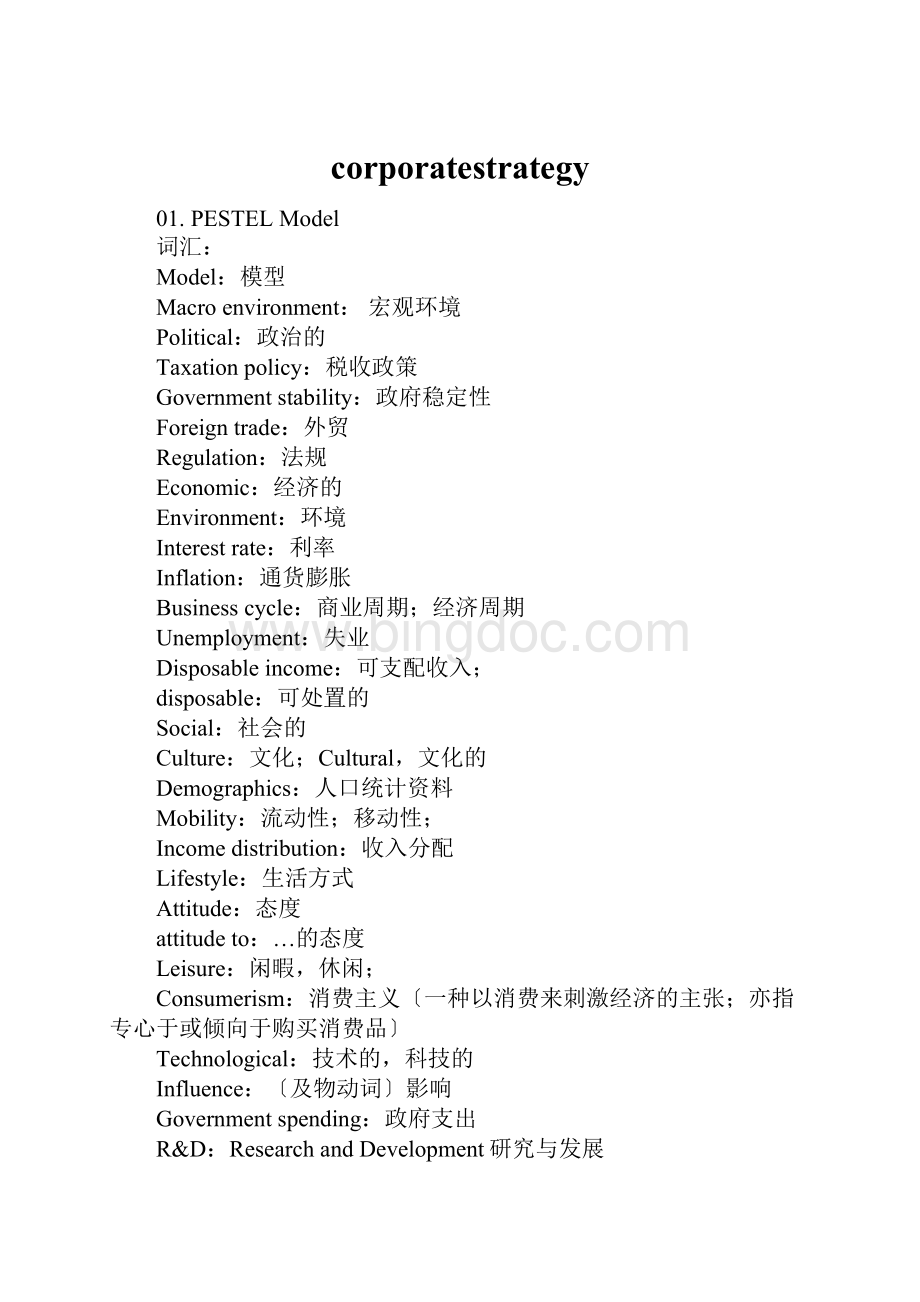corporatestrategy.docx
《corporatestrategy.docx》由会员分享,可在线阅读,更多相关《corporatestrategy.docx(19页珍藏版)》请在冰点文库上搜索。

corporatestrategy
01.PESTELModel
词汇:
Model:
模型
Macroenvironment:
宏观环境
Political:
政治的
Taxationpolicy:
税收政策
Governmentstability:
政府稳定性
Foreigntrade:
外贸
Regulation:
法规
Economic:
经济的
Environment:
环境
Interestrate:
利率
Inflation:
通货膨胀
Businesscycle:
商业周期;经济周期
Unemployment:
失业
Disposableincome:
可支配收入;
disposable:
可处置的
Social:
社会的
Culture:
文化;Cultural,文化的
Demographics:
人口统计资料
Mobility:
流动性;移动性;
Incomedistribution:
收入分配
Lifestyle:
生活方式
Attitude:
态度
attitudeto:
…的态度
Leisure:
闲暇,休闲;
Consumerism:
消费主义〔一种以消费来刺激经济的主张;亦指专心于或倾向于购买消费品〕
Technological:
技术的,科技的
Influence:
〔及物动词〕影响
Governmentspending:
政府支出
R&D:
ResearchandDevelopment研究与发展
Focus:
聚焦;焦点
Obsolescence:
过时;
rateofobsolescence:
淘汰速度,更新换代速度
Ecological:
生态的,生态学的
Monopoly:
垄断
Legislation:
立法
Environmentprotectionlaw:
环境保护法
ThePESTELmodelstudiesthemacroenvironmentinthefollowingaspects:
PESTEL模型主要从以下几方面来研究宏观环境:
1.Political.Thepoliticalenvironmentincludestaxationpolicy,governmentstabilityandforeigntraderegulations.政治环境。
政治环境包括税收政策、政府稳定性和外贸法规等因素。
2.Economic.Theeconomicenvironmentincludesinterestrates,inflation,businesscycles,unemployment,disposableincomeandenergyavailabilityandcost.经济环境。
经济环境包括利率、通货膨胀水平、商业周期、失业水平、可支配收入和能源供给及成本等因素。
3.Social.Thesocial/culturalenvironmentincludespopulationdemographics,socialmobility,incomedistribution,lifestylechanges,attitudestoworkandleisure,levelsofeducationandconsumerism.社会文化环境。
社会文化环境包括人口统计情况、社会流动性、收入分配、生活方式变迁、工作休闲态度、教育水平和消费理念等因素
4.Technological.Thetechnologicalenvironmentisinfluencedbygovernmentspendingonresearch,newdiscoveriesanddevelopment,governmentandindustryfocusoftechnologicaleffort,speedoftechnologicaltransferandratesofobsolescence.
技术环境。
科技环境通常受政府在研发方面支出水平的影响,同时也受政府、行业确定的科技发展方向以及技术转移及淘汰速度的影响。
5.Ecological/environmental.Theecologicalenvironment,sometimesjustreferredtoas‘theenvironment’,considerswaysinwhichtheorganizationcanproduceitsgoodsorserviceswiththeminimumenvironmentaldamage.生态环境。
生态环境通常就是指我们生活的这个环境,在此通常要考虑的是组织要以对环境产生最小破坏的方式来生产商品或提供劳务。
6.Legal.Thelegalenvironmentcoversinfluencessuchastaxation,employmentlaw,monopolylegislationandenvironmentalprotectionlaws.法律环境。
法律环境通常考虑税法、劳动法、垄断法、环境保护法等法律对组织的影响。
02.行业生命周期IndustryLifeCycle
词汇:
Introduction,growth,maturityanddecline:
起步/成长/成熟/衰退期
Characteristics:
特色,特点
Prospective:
〔名词〕预期,展望〔形容词〕未来的,预期的
Feature:
特征
Position:
〔动词〕定位
Awareness:
意识,知道,认识
Marketgrowthrate:
市场增长率
Patent:
专利
Intensive:
集中的,加强的
Well-informed:
消息灵通的,见多识广的
Shake-out:
摇动,抖动,动乱
Industryconcentration:
行业集中
Marketsegmentation:
市场细分
Grab:
〔动词〕攫取,抓住,抢得
M&A〔MergersandAcquisitions〕:
并购
Overcapacity:
产能过剩
Dramatically:
剧烈地
Dieout:
消失,灭绝
Competitiveadvantage:
竞争优势
行业生命周期IndustryLifeCycle
阶段stages 特征characteristics
起步期
Introduction Theentityisusuallysmall.
Thereexistsdifferentprospectiveforthefuture.
Marketingstrategyshouldfocusoncorrectingproductproblemsindesign,features,andpositioningsoastoestablishacompetitiveadvantageanddevelopproductawarenessthroughadvertising,promotionandpersonalsalestechniques.
Theprofitabilityisrelativelylow.
Marketgrowthrateishigh.
Themanagementoftheentityshouldcarryoutcorrespondingstrategiestosupportthelaunchofthenewproductsandmonitorthecompetitors’latestprogress.
企业规模较小;对未来发展有不同的看法;营销策略主要关注于产品设计、特征及定位的修正以建立起竞争优势,同时通过广告、促销、个人销售手段来增强消费者对产品的认知度;盈利性较低;市场增长率较高。
管理层要采取相应的战略来支持新品上市,同时关注竞争对手的最新动态。
成长期
Growth Theindustrygrowsquickly.
Theentityneedstofinanceforthemarketexpansionandalwaysfacestheshortageofcash.
Themanagementoftheentitymustachievethetargetmarketsharebyincreasingtheproduction.Andatthesametimetheentitycanalsoestablishthe“industrybarrier”bythepatents,lowcostsandanyothermethods.
成长期:
行业增长迅速;企业需要大量资金来实现市场扩张,因此面临资金的短缺。
管理层必须通过扩大产量来到达公司设定的目标市场份额。
同时通过专利、低成本及其他方法来建立阻止竞争者进入的“行业壁垒”。
成熟期
Maturity Thegrowthrateoftheindustrydeclinesandbecomesstablegradually.
Thereexistsintensivecompetitioninthemarket.
Thecustomersarewell-informed.
Onlyafewlargerplayersremainintheindustryaftertheshake-outofindustryinthelatematuritywhichleadstoincreasedindustryconcentration.
Theentityshouldfocusontheefficiency,costcontrolandmarketsegmentation.Inthelatematurity,theentityshouldgrabtheopportunityforM&AandfocusontheR&Dforthefurtherdevelopmentofnewmarketsandnewtechnologies.
成熟期:
行业增长率降低趋于稳定;市场竞争更加激烈;消费者见多识广;成熟期后期行业剧烈动乱仅留下较大的企业,从而导致较高的行业集中度。
企业应重点关注效率、成本控制和市场细分。
在成熟期后期,企业应抓住兼并时机,重点关注研发以开拓新市场和获取新技术。
衰退期
Decline Theindustrysuffersfromovercapacity.
Marketgrowthratedeclinesdramatically.
Thereexistfewerkindsofproductsandentitiesintheindustry.Evenfinallytheindustrywilldieout.
Themanagementoftheentityshouldcontinuetokeepthecompetitiveadvantageinsuchsituation.Sointhisstagestrategymanagementisveryimportanttotheentity.
衰退期:
行业产能过剩;市场增长率大幅下降;产品品种和企业数量进一步减少,行业甚至有可能消亡。
管理层在这样一个环境下,应继续保持竞争性优势。
因此在这个阶段战略管理显得尤为重要。
03.FiveForcesModelofCompetition波特的五力模型
波特的五力模型FiveForcesModelofCompetition
Notes
Entrant:
进入者
Extra:
额外的
Capacity:
能力,容量,资格,地位,生产力
Intensify:
加剧
Competition:
竞争
Barrierstoentry:
进入壁垒
Foothold:
立足处,据点,立锥之地
Thethreatofnewentrants
Newentrantsintoanindustrywillbringextracapacityandintensifycompetition.Thestrengthofthisthreatdependsuponthestrengthofthebarrierstoentryandthelikelyresponseofexistingcompetitorstothenewentrant.Barrierstoentryareunfavorablefactorsthatmakeitdifficultforanewentranttogainaninitialfootholdinamarket.
新进入者的威胁
新进入者为市场带来了额外的生产能力,进而加剧了市场的竞争。
来自新进入者的威胁大小取决于行业壁垒高低和现有企业对新进入者的反应。
所谓的进入壁垒就是指那些使新进入者难于在市场立足的不利因素。
Notes
Economicsofscale:
规模经济
Unitcost:
单位成本
Decline:
下降
Significantly:
显著地,大幅度地
Volume:
量,卷
CVPanalysis:
本量利分析
Increase:
增加
Decrease:
减少
Suchthat/sothat:
如此……以致于
Beabletodosth:
有能力去做某事
Onthebasisof:
在……的基础上
Comparable:
可比较的
Differentiation:
差异
Brandimage:
品牌形象
Customerloyalty:
客户忠诚度
Overcome:
克服
Prohibitive:
禁止的,〔费用,价格等〕过高的
Transport:
交通,运输
Switchingcost:
转换成本
One-off:
一次性的
Accessto:
接近,有权使用
Distributionchannel:
分销渠道
Costadvantage:
成本优势
Disadvantage:
不利,劣势
Independent:
独立的,不依赖……的,不受……支配的
Subsidy:
补贴
Know-how:
专有技术
Barrierstoentry1
•Economiesofscale.Theindustryisonewhereunitcostsdeclinesignificantlyasvolumeincreases,sothatanewentrantwillbeunabletostartonacomparablecostbasis.
•Productdifferentiation.Establishedfirmsinanindustrymayhavebuiltupagoodbrandimageandcustomerloyalty.Thecostsofovercomingthisbarriertoentryforanewentrantcanbeprohibitive.
•Capitalrequirements.Wherecapitalinvestmentrequirementsarehigh,thebarrieragainstnewentrantswillbestrong.〔e.g.steelindustry,railtransport〕.
Barrierstoentry2
•Switchingcosts.Switchingcostsrefertotheone-offcosts〔time,moneyandconvenience〕thatacustomerwouldhavetoincurbyswitchingfromonesuppliertoanother.
•Accesstodistributionchannels.Distributionchannelscarryamanufacturer’sproducttoend-buyer.Fornewentrants,newdistributionchannelsaredifficulttoestablish,andexistingdistributionchannelsarehardtogainaccessto.
•Costadvantagesofexistingproducers,independentofeconomiesofscaleinclude:
〔i〕Patentrights;〔ii〕Experienceandknow-how;〔iii〕Governmentsubsidies;〔iv〕Lawsandregulations;〔v〕Favoredaccesstosuppliers
常见的进入壁垒有:
规模经济。
规模经济表现为在一定时间内产品的单位成本随总产量的增加而降低,而新进入者则不能一开始就到达此成本水平。
产品差异性。
行业内已建立的公司拥有较好的品牌形象和客户忠诚度。
如果行业新进入者想克服这个壁垒,则代价是巨大的。
资本金投入要求。
某些行业需要前期投入较大的资本金,则给新进入者设置的进入壁垒较高,比方说钢铁行业、铁路运输等。
转换成本。
即从一个供给商转换到另一个供给商的一次性成本〔包括时间、金钱和便利〕。
对分销渠道的使用权。
分销渠道使生产商的产品被运往终端消费者。
对新进入者来说,新的分销渠道难以建立,并且现有的分销渠道难以获得。
现有产品的成本优势〔与规模经济无关〕包括:
〔i〕专利权;〔ii〕经验和专有技术;〔iii〕政府补贴;〔iv〕法律法规;〔v〕最优惠供给资源
04.Porter’sValueChain波特的价值链模型
Notes
Valuechain:
价值链
Identify:
识别
Contributeto:
有助于
Competitiveadvantage:
竞争优势
Approach:
方法论,方法;靠近〔vt.〕
Breakdown…into:
分解成…
Primary:
基本的,主要的
Firminfrastructure:
企业的基础设施建设
Humanresourcemanagement:
人力资源管理
Technologydevelopment:
技术开发
Procurement:
采购
Porterdevelopedthevaluechaintohelpidentifywhichactivitieswithinthefirmwerecontributingtoacompetitiveadvantageandwhichwerenot.
Theapproachinvolvesbreakingdownthefirmintofive“primary”andfour“support”activities,andinvestigatingeachtoseeiftheygiveacostadvantageorqualityadvantage.
波特提出了价值链模型,借此识别哪些活动会给公司带来竞争优势,哪些则不能。
该理论将公司划分为五种基本活动和四种辅助活动,并对每一种活动进行考察,以确定其是否可以为公司带来成本优势或质量优势。
05.SWOTModel/SWOT模型
Notes:
SWOT
即Strength,Weakness,Opportunity,Threat的缩写,优势、劣势、时机、威胁
Internal/External:
内部的/外部的
Unique:
唯一的,独一无二的
Favorable:
有利的
Unfavorable:
不利的〔un为前缀,表示否认〕
TheSWOTanalysisincludesfourelements-strengths,weaknesses,opportunitiesandthreats.
•Strength.Itmeansthepositivefactorsoruniquecapabilitieswhichresultinthecompetitiveadvantages.
•Weakness.Itmeansthefactorswhichrestrictthedevelopmentofthefirm.
•Opportunity.Itmeansthecircumstanceswhicharefavorabletothedevelopmentofthefirmastheexternalenvironmentischanging.
•Threat.Itmeansthecircumstanceswhichareunfavorabletothedevelopmentofthefirmastheexternalenvironmentischanging.
SWOT分析的四要素为优势、劣势、时机与威胁。
•优势:
是指能为企业带来重要竞争优势的积极因素或独特能力。
•劣势:
是指限制企业发展且有待改正的消极方面。
•时机:
是随着企业外部环境的改变而产生的有利于企业的时机。
•威胁:
是随着企业外部环境的改变而产生的不利于企业的时机。
06.GenericStrategies
Notes
Genericst